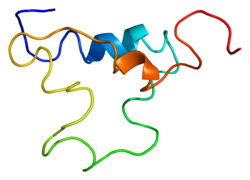| Fator de crescimento semelhante à insulina tipo 1 |
|---|
 Fonte: Protein Data Bank |
| Estruturas disponíveis | | PDB | Busca de ortólogos: PDBe, RCSB | | Lista de códigos PDB | | 1B9G, 1GZR, 1GZY, 1GZZ, 1H02, 1H59, 1IMX, 1PMX, 1TGR, 1WQJ, 2DSR, 2GF1, 3GF1, 3LRI | | |
| Identificadores |
|---|
| Símbolos | IGF1; IGF-I; IGF1A; IGFI |
|---|
| IDs externos | OMIM: 147440 MGI: 96432 HomoloGene: 515 GeneCards: IGF1 Gene |
|---|
| Ontologia do gene | | Função molecular | •insulin receptor binding
•insulin-like growth factor receptor binding
•integrin binding
•hormone activity
•protein binding
•growth factor activity
| | Componente celular | •extracellular region
•extracellular space
•plasma membrane
•insulin-like growth factor binding protein complex
•platelet alpha granule lumen
| | Processo biológico | •skeletal system development
•blood vessel remodeling
•platelet degranulation
•DNA replication
•cellular component movement
•signal transduction
•Ras protein signal transduction
•muscle organ development
•blood coagulation
•positive regulation of cell proliferation
•negative regulation of cell proliferation
•glycolate metabolic process
•glial cell differentiation
•positive regulation of cardiac muscle hypertrophy
•positive regulation of phosphatidylinositol 3-kinase cascade
•satellite cell maintenance involved in skeletal muscle regeneration
•muscle hypertrophy
•myotube cell development
•positive regulation of smooth muscle cell migration
•positive regulation of cerebellar granule cell precursor proliferation
•water homeostasis
•proteoglycan biosynthetic process
•platelet activation
•mammary gland development
•exocrine pancreas development
•regulation of establishment or maintenance of cell polarity
•positive regulation of protein import into nucleus, translocation
•negative regulation of smooth muscle cell apoptotic process
•multicellular organism growth
•bone mineralization involved in bone maturation
•regulation of multicellular organism growth
•positive regulation of activated T cell proliferation
•positive regulation of tyrosine phosphorylation of Stat5 protein
•negative regulation of apoptotic process
•positive regulation of DNA binding
•positive regulation of MAPK cascade
•positive regulation of insulin-like growth factor receptor signaling pathway
•cellular protein metabolic process
•myoblast differentiation
•positive regulation of osteoblast differentiation
•positive regulation of glycogen biosynthetic process
•positive regulation of DNA replication
•positive regulation of glycolysis
•positive regulation of mitosis
•positive regulation of transcription, DNA-dependent
•positive regulation of transcription from RNA polymerase II promoter
•positive regulation of glucose import
•positive regulation of Ras protein signal transduction
•insulin-like growth factor receptor signaling pathway
•phosphatidylinositol-mediated signaling
•positive regulation of fibroblast proliferation
•lung alveolus development
•positive regulation of smooth muscle cell proliferation
•branching morphogenesis of an epithelial tube
•inner ear development
•chondroitin sulfate proteoglycan biosynthetic process
•positive regulation of epithelial cell proliferation
•positive regulation of peptidyl-tyrosine phosphorylation
•myoblast proliferation
•positive regulation of protein kinase B signaling cascade
•lung vasculature development
•lung lobe morphogenesis
•Type I pneumocyte differentiation
•Type II pneumocyte differentiation
•prostate epithelial cord arborization involved in prostate glandular acinus morphogenesis
•prostate gland growth
•prostate gland stromal morphogenesis
•negative regulation of androgen receptor signaling pathway
•negative regulation of ERK1 and ERK2 cascade
•positive regulation of calcineurin-NFAT signaling cascade
•negative regulation of release of cytochrome c from mitochondria
•positive regulation of myoblast proliferation
| | Sources: Amigo / QuickGO | |
| Padrões de expressão do ARN |
|---|
 |
 |
 |
| Mais dados de expressão |
| Ortólogos |
|---|
| Espécies | Humano | Rato |
|---|
| Entrez | 3479 | 16000 |
|---|
| Ensembl | ENSG00000017427 | ENSMUSG00000020053 |
|---|
| UniProt | P05019 | P05017 |
|---|
| RefSeq (mRNA) | NM_000618 | NM_001111274 |
|---|
| RefSeq (proteína) | NP_000609 | NP_001104744 |
|---|
| Localização (UCSC) | Chr 12:
102.79 – 102.87 Mb | Chr 10:
87.86 – 87.94 Mb |
|---|
| Busca PubMed | [1] | [2] |
|---|
|
Fator de crescimento semelhante à insulina tipo 1, somatomedina C ou IGF-1 é uma proteína produzida no fígado em resposta ao hormônio de crescimento (GH) com papel importante no crescimento, desenvolvimento da musculatura, diminui os níveis de glicose no sangue, reduz os níveis de gordura corporal, altera a oxidação lipídica e aumenta a síntese de proteínas.[1]
Função
Em humanos, o GH e enquanto o IGF-I desencadeia o aumento da oxidação lipídica apenas cronicamente. Enquanto as ações sobre o crescimento são tempo limitado, as ações metabólicas e cardiovasculares do eixo GH/IGF-I perduram durante toda a vida.[1]
Apesar de muito similar à insulina, enquanto o receptor de insulina é altamente comum no fígado e tecido adiposo branco em adultos, o receptor de IGF-I é raro nesses locais, sendo mais comum no músculo esquelético, onde estimula a diferenciação celular.
Uso terapeutico
Análogos sintéticos da IGF-1, como a mecassermina, podem ser utilizados para o tratamento de atraso no crescimento e podem retardar processos neurodegenerativos como mal de Alzheimer.[2]
Patologias
Um alto nível de IGF-1 aumenta o risco de câncer, diabetes e aceleram o envelhecimento.
Incapacidade de produzir IGF-1 causa um menor crescimento e tendência a obesidade em crianças e adolescentes, popularmente conhecido como nanismo.
Ver também
Referências
- ↑ a b Carla R.P. Oliveira, Rafael A. Meneguz-Moreno, Manuel H. Aguiar-Oliveira, José A. S. Barreto-Filho. Papel Emergente do Eixo GH/IGF-I no Controle Cardiometabólico. Universidade Federal de Sergipe, Aracaju, SE, Brasil. http://www.scielo.br/pdf/abc/v97n5/v97n5a12.pdf
- ↑ Insulin-like growth factor-I: potential for treatment of motor neuronal disorders. Lewis ME, Neff NT, Contreras PC, Stong DB, Oppenheim RW, Grebow PE, Vaught JL.SourceCephalon, Inc., West Chester, Pennsylvania 19380!
|
|---|
Glândulas
endócrinas | |
|---|
Glândulas
não-endócrinas | |
|---|
 | Este artigo sobre proteínas é um esboço. Você pode ajudar a Wikipédia expandindo-o. |
















